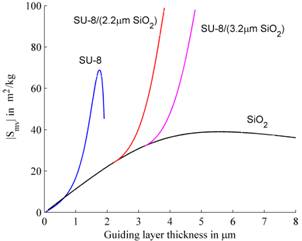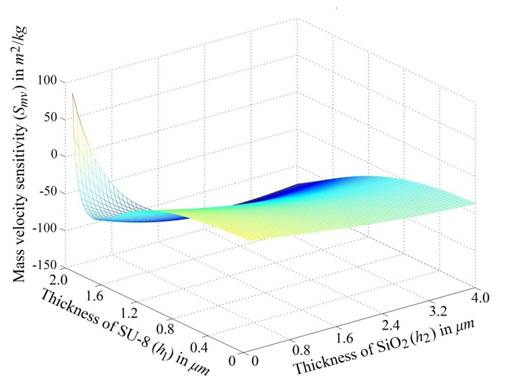Love waves have been extensively investigated on the theories or experiments since they were first introduced in sensing area. A desirable waveguide material should have a low propagation loss, a good chemical stability and corrosion resistance and a slow transverse acoustic wave.
Among the materials, SiO2 and polymer are commonly used guiding layer ones. SiO2 has merits of low acoustic loss and good resistance to water and most chemicals. However, Love wave sensors with a SiO2 have the disadvantages of low sensitivity and consistent TCF with the quartz substrate. Although polymeric substances have opposite TCFs, lower mass densities and less shear stiffness to realize good temperature stability and large sensitivity, they have a shortcoming of large propagation loss caused by viscosity.
To achieve the advantages of SiO2 and polymeric materials, some researchers were devoted to the sensor with two guiding layers. Their experimental results show that a Love mode sensor with such a structure can achieve a more stable temperature performance, a larger mass loading sensitivity and an acceptable insertion loss. These results indicate the potential applications of Love wave device with multiple layers in the field of gas sensing.
Researcher LIU Jiansheng from the Institute of Acoustics, Chinese Academy of Sciences is committed to establish a theoretical model for analyzing the performance of Love wave sensors based on a structure with multiple viscoelastic guiding layers on a piezoelectric substrate. The dispersion equation for Love waves in such a structure is obtained and the parameters for describing the performance of Love mode sensors are presented.
A Maxwell-Weichert model is introduced to describe the viscoelasticity of a polymeric material. Numerical calculations are brought out for a sensor based on a Love wave delay line consisting of an elastic SiO2 layer, a viscoelastic SU-8 layer, an ST-90˚X quartz substrate and two IDTs with a period of 40 μm deposited on the substrate surface.
The results prove that a Love wave sensor with such a two-layer structure can achieve better performances than with only one viscoelastic or elastic guiding layer. Some interesting results such as an oscillation in Smv, are obtained and these researches will be beneficial to the development of Love wave sensors with better performances.

Fig.1 Comparison between the calculated |Smv| surfaces of the fundamental Love mode wave in different layered structures (λ = 40 μm) (Image by LIU)

Fig.2 Calculated mass velocity sensitivity surface of the fundamental Love mode wave in the layered structure of SU-8/SiO2/ST-90˚X quartz (λ = 40 μm) (Image by LIU)
Journal References:
LIU Jiansheng. A Theoretical Study on Love Wave Sensors in a Structure with Multiple Viscoelastic Layers on a Piezoelectric Substrate. Smart Materials and Structures (Vol.23, No. 7, 075015, 8pp, June 2014). DOI:10.1088/0964-1726/23/7/075015
Corresponding Author:
LIU Jiansheng
Institute of Acoustics, Chinese Academy of Sciences, Beijing 100190, China
Email: liujs98@hotmail.com or liujiansheng@mail.ioa.ac.cn


